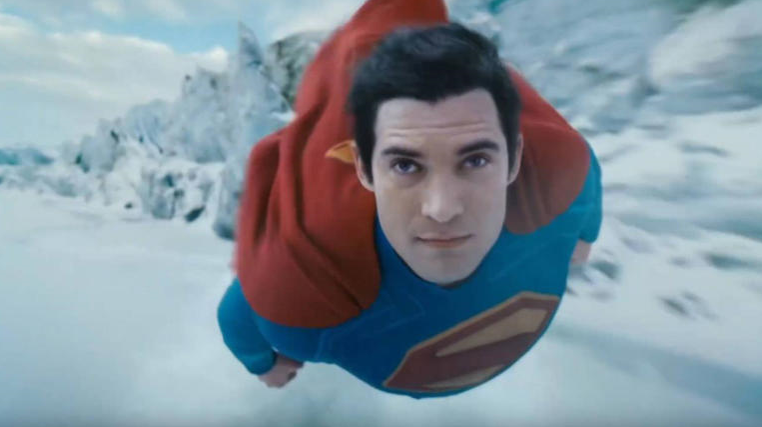
Supposedly leading the charge in the new (and improved) DC universe, (or, at least, that’s what Warner Bros. wanted you to believe), the new Superman movie is officially in theaters. Sadly, this Superman movie is anything but that. Instead, it’s got as much of a chance at making progress as a gay pride parade on a blood-splattered battlefield – and it desperately needs to deliver on the hope that makes a Superman movie great. For Hollywood currently suffering from artistic heart failure, that’s a tall order, maybe even unfair. Spoiler alert: There’s no hope here.
A great story is character-driven – genuine heart, no flashy plot – but James Gunn’s Superman, starring David Corenswet, (sidestepping body odor jokes), flips that script. This film is overloaded with plot clutter, packed tighter than the actor’s costumed underwear, and has as much honesty and depth as cast comments on the red carpet. It’s got the hallmarks of a former Marvel director’s cheap gimmicks: hit-or-miss humor, bright colors, weird aliens, and pets doing silly things. But does it have soul? As much as a rock does, yes. I mean, hey, that soulless strategy made Marvel billions. Why not ruin Superman, too?
Let’s get into it. Wrap your inner child in a warm, Superman-emblem blanket, put a good Superman movie on starring Christopher Reeves, close the door, and come outside to see the Kent farm in ruins. Face the destruction dispassionately. Can’t say I didn’t warn you.
Krypto the Annoying
The dog’s supposed to be Superman’s loyal companion, but he’s just a constant, distracting presence – playful whether the stakes are life or leisure, contributing nothing but irritation, clogging an already backed-up plot.
Superman, the Punching Bag
The Man of Steel spends more time taking hits than dishing them out and even throws a tantrum in front of Lex. While he’s supposed to draw strength from the sun, he seems to be as emotionally driven and unstable as characters written to deliver a killing blow regardless of the collateral damage. Superman stands for truth, just, and the American way, something Bruce Timm’s Superman embodied with timeless fashion. Yet this screen treatment of such a well-established character feels insecure, conscious of the shadow cast by all previous iterations, though, to give credit where credit is due, this Superman is not nearly as emotionally driven than Zack Snyder’s Superman played by Henry Cavill. But where Cavill’s Superman showed confidence in 2012, Gunn’s Superman has no identity.
The Lore, or What’s Left of It
Gunn’s creativity here feels less a superpower and more a liability. He depicts the Kryptonian parents as power-hungry rulers. Kal-El’s birth parents want him to subjugate Earth and have many wives. Where Gunn saw this as a good angle for the story, it’ll forever remain unclear. There’s never a question of whether Kal-El will do as his parents wished. That’s not who he is, inside or outside this movie. Superman exists outside the studio system in the hearts and minds of fans, so this plot twist is a non-starter in so far as Superman’s character is concerned. Now, sure, it does make his relationship with the inhabitants of Earth a bit wobbly, but even that has no meaningful impact on the film’s plot. Meanwhile, the Kents? They’re technologically clueless farm folk. They squabble and undercut each other when they should emulate the moral upbringing that made Clark Kent-Superman who he is today, but they’re hardly the moral anchors the “alien refugee” was raised by in better installments.
The Lex vs Superman Showdown
Lex Luthor fights through a keyboard-commanded surrogate clone in a high-rise command-center, which feels more like a high-end call center than the lair of an arch-villain. After a decade without Superman films, this is the “thrilling” third act we get? A fight between a weakened Superman and a clone of himself controlled by a button-mashing Lex Luthor? To add insult to injury, a wasted Supergirl shows up before credits roll just to pick up Krypto. Maybe the scene would have fit better in a stronger script, whether it’s comic book accurate or not.
If that weren’t enough, the supporting heroes – the “Justice Gang” of Green Lantern, Mr. Fantastic, and Hawk Girl – offer mixed bag performances. Hawk Girl, powerful but immature; Green Lanter, played by fan-favorite Nathan Fillion, under-utilized by a weak script; and Mr. Terrific, scene stealer, showcasing the competence and confidence Superman sorely lacks throughout this whole picture.
A Script Undeserving of “Superman”
The movie’s own theme collapses under a heaping of CGI led. Superman faces the choice between heroism or villainy, but the story barely gives him time to wear the shoes of Clark Kent – his essential, grounded alter ego – before burying him in scenes that feel more like Guardians of the Galaxy than anything from Superman’s universe. Clark’s relationship with Lois Lane, which should have served as the emotional anchor of the story, instead feels like a fragmented sentence, incomplete and barely explored. Though, brief moments of hope do spark. However, they are far too fleeting.
James Gunn, Studio Darling or Creative Liability?
Why Warner Bros. picked James Gunn to direct this iconic character is anyone’s guess. This movie treats Superman with the same careless management Disney showed the Star Wars sequel trilogy – a beloved legacy mishandled, leaving fans frustrated and disappointed. Instead of unlocking the secret of Superman, Gunn seems to have jammed the wrong key in the lock, smashed it beyond repair, and called studio executives to break in with an axe, completely counter to his previous claim that he had “unlocked the secret” to the character in this movie.
